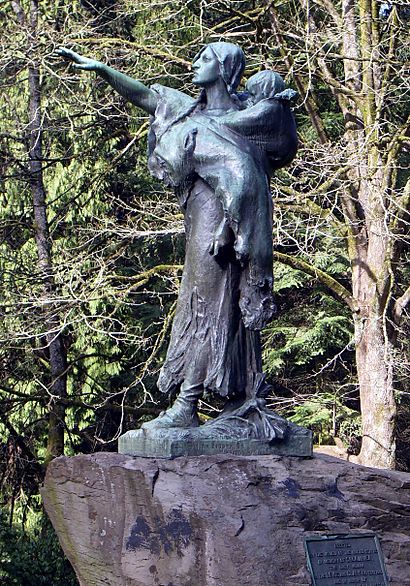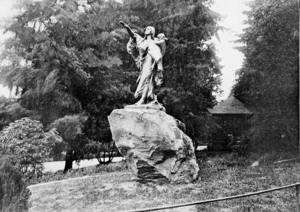Sacajawea and Jean-Baptiste facts for kids
Quick facts for kids Sacajawea and Jean-Baptiste |
|
|---|---|

The sculpture in 2006
|
|
| Artist | Alice Cooper |
| Year | 1905 |
| Type | Sculpture |
| Medium | Bronze |
| Subject | Sacagawea and Jean Baptiste Charbonneau |
| Dimensions | 2.1 m × 1.1 m × 0.91 m (7 ft × 3.5 ft × 3 ft) |
| Location | Portland, Oregon, United States |
| 45°31′17″N 122°42′08″W / 45.521448°N 122.702287°W | |
Sacajawea and Jean-Baptiste is a beautiful bronze sculpture located in Washington Park in Portland, Oregon. It was created by American artist Alice Cooper. The sculpture shows Sacagawea, a famous Native American woman, with her young son, Jean Baptiste Charbonneau.
What Does the Sacajawea Sculpture Look Like?
The Sacajawea and Jean-Baptiste sculpture was designed by Alice Cooper (1875–1937). It is an outdoor bronze sculpture found in Washington Park in Portland, Oregon. The artwork shows Sacagawea, a Lemhi Shoshone woman. She was an important guide for the Lewis and Clark Expedition as they explored the western parts of the United States. Her son, Jean Baptiste Charbonneau, is also part of the sculpture. The statue is about 7 feet (2.1 meters) tall, 3.5 feet (1.1 meters) wide, and 3 feet (0.9 meters) deep.
When Was the Sacajawea Statue Created?
The sculpture was made for the Lewis and Clark Centennial Exposition in 1905. A group called the Committee of Portland Women asked for it. They wanted a sculpture to honor "the only woman in the Lewis and Clark Expedition" and "the pioneer mother of old Oregon." Money for the statue came from the Port of Portland and women's groups across the Western United States.
Unveiling and Location of the Statue
The sculpture was first shown to the public on July 6, 1905. It stood in the middle of the exposition's main area. Many important women who supported women's right to vote, like Susan B. Anthony, Abigail Scott Duniway, and Anna Howard Shaw, were there. After the fair ended, the statue was moved to Washington Park on April 6, 1906. The Regional Arts & Culture Council takes care of the sculpture today. They say that Alice Cooper was the first female artist to have her work in Portland's public art collection.


